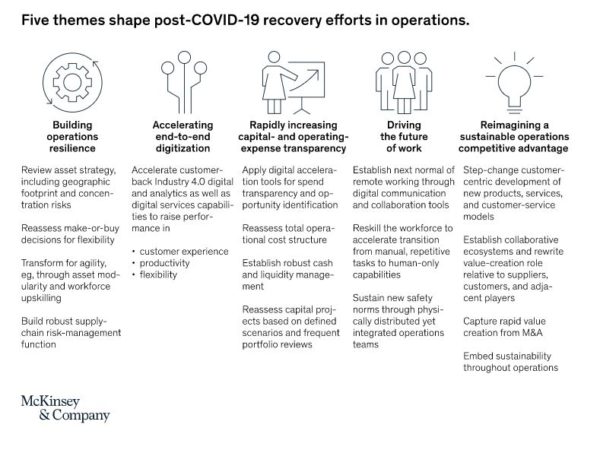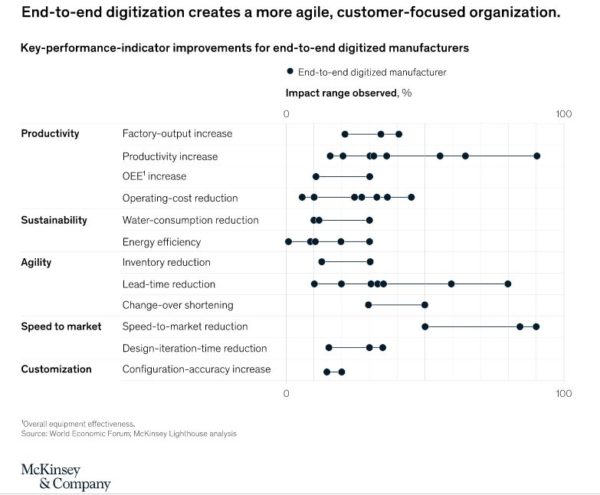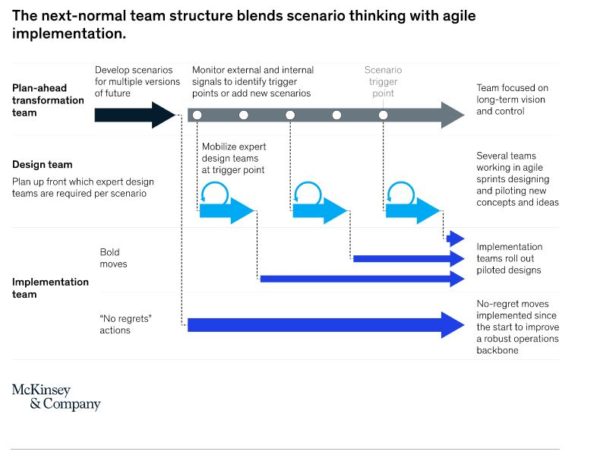COVID-19 has created an imperative for companies to reconfigure their operations, and an opportunity to transform them
The coronavirus pandemic has radically changed the demand for products and services in every sector while exposing points of weakness and fragility in global supply chains and service networks. At the same time, it has been striking how well and how fast many companies have adapted, achieving new levels of visibility, agility, productivity, and end-customer connectivity—while also preserving their cash. Leading retailers have boosted their e-commerce capabilities, delivering food to thousands of customers confined in their homes. One European healthcare provider abandoned its two-year plan for the rollout of e-health services and deployed the new remote treatment system to thousands of patients in only ten days.
The virus has shown that, when they align around a common purpose, operations teams can achieve goals that would have been considered impossible before the crisis. As they plan their transition to the next normal, companies are looking for ways to maintain this sense of purpose and speed.
In our conversations with operations leaders, we find that many are energized and inspired by the progress the crisis has forced them to make. Production lines have achieved record levels of availability and output: one automotive company found that manufacturing productivity actually increased when it introduced physical-distancing measures. After switching to daily planning cycles and gaining real-time visibility of their operations, managers don’t want to return to the old cadence of monthly planning and metrics that lag behind the situation on the ground. With physical stores closed, online and direct-to-customer sales are booming in many categories. That’s inspiring companies to upgrade their sales and distribution capabilities to meet this new type of demand.
Across industries, companies are realizing that they can aspire to much more than simply a safe return to work. They want to take what they have learned during the COVID-19 crisis and create a new kind of operational performance. Our ongoing discussions with leaders in multiple industries suggest that this effort will focus on five key themes.


Building operations resilience
Successful companies will redesign their operations and their supply chains to protect their business against a wider and more acute range of potential shocks and disruptive events. That calls for action on three fronts.
First, companies will revisit their global asset footprint. In consumer services, for example, we expect the crisis to significantly increase the adoption of online and omnichannel delivery models. As leading banks restart their retail operations, some are considering substantial changes to their branch networks to better match reshaped demand patterns.
The trend for product value chains to become more regionalized is also likely to accelerate, as companies reassess the risks of globally integrated asset networks and supply chains. For example, to increase agility in the event of regional shutdowns, a leading fashion company has already started to develop new supply sources beyond its current network in Southeast Asia.
Second, companies will likely reassess their make-versus-buy options. A leading consumer company has accelerated the outsourcing of manufacturing and logistics for some products to specialized players in different regions. This approach improves the security of supply, thanks to increased local content, while also reducing costs and allowing the company to ramp volumes up or down more rapidly.
Third, more companies will set up dedicated supply-chain risk-management functions. Working alongside the manufacturing, procurement, and supply-chain functions, these units assess vulnerabilities across supply nodes and apply robust risk-mitigation frameworks to address those vulnerabilities. The resulting actions might involve accelerating decentralization, deploying inventory closer to customers, and developing crisis-response plans and capabilities.
To win in the next-normal environment, companies will need to achieve this step-change in resilience without unsustainable increases in their costs. The acceleration of end-to-end operations digitization, which is described next, will be critical in resolving the long-standing trade-off between efficiency and resilience. New digital technologies are already improving companies’ ability to predict problems, make effective decisions, and rapidly adapt their operations in response.
Accelerating end-to-end digitization
Before the coronavirus hit, most companies were already accelerating the digital transformation of their customer journeys and value chains. We expect digital technologies to be at the core of the next normal, enabling organizations to better meet the needs of their customers, and improving the agility and responsiveness of operations without increasing their costs. Research by the World Economic Forum, in collaboration with McKinsey, shows that companies often achieve significant and simultaneous improvements across multiple performance measures when they integrate advanced digital technologies across the value chain.

During the crisis, many companies have been able to overcome staff shortages by automating processes or developing self-service systems for customers. These approaches can accelerate workflows and reduce errors—and customers often prefer them. One telecom player found that it could apply robotic process automation (RPA) to more than 50 percent of its back-office and invoicing tasks. And in its technical call centers, up to half of all tasks could be automated, freeing up agents to deal with the complex queries where they could add the most value.
Digital approaches can transform customer experience and significantly boost enterprise value when applied end to end. Before the crisis, one North American insurer recognized that it needed to fundamentally change its offerings and the way it engaged with customers and agents. The company rebuilt its entire operating model, starting with a deep understanding of customer needs, a refreshed product shelf, and an integrated set of changes (including digital, analytics, and lean management) to meet those needs. The organization invested in a strategic set of hires and the development of design, digital, and advanced analytics capabilities.
It continued to weave the same digital thread through all back-office operations, redesigning and automating its processes and outsourcing activities where it made sense to do so. The new approach dramatically increased the speed and efficiency of the company’s operations: policy-servicing tasks that used to take 20 days are now completed in two, and products are brought to market three times faster. Overall, the holistic transformation has put the organization on a path to $1 billion in additional enterprise value.
A leading healthcare company has employed digital tools across its entire value chain, offering user-friendly product evaluation and selection software for patients and medical professionals and using advanced analytics and real-time planning to control its complex direct-to-customer supply chain. The company has also built a modular digital platform to accelerate the introduction of new products. The system uses robots, advanced control systems, and Internet of Things (IoT) technologies, built into interchangeable hardware “blocks” that allow the rapid configuration of production lines. Dedicated simulation software accelerates the qualification of new production lines and the scale-up of production. Finally, as discussed later under “Reimagining a sustainable operation competitive advantage,” companies are using digital platforms that connect the entire value chain to create innovative business models.
Rapidly increasing capital- and operating-expense transparency
The economic fallout from the COVID-19 crisis will outlive the pandemic itself. We know companies will need to build their next-normal operations around a different cost structure. They will need to make these changes quickly.
Organizations can begin with an in-depth review of their operating costs. Technology-enabled methodologies can significantly accelerate cost-transparency work, compressing months of effort into weeks or days. These digital approaches include procurement-spending analysis and clean-sheeting, end-to-end inventory rebalancing, and capital-spend diagnostics and portfolio rationalization. One leading retailer has used the drop in activity triggered by the crisis to conduct a systematic, cross-functional review of its network, logistics operations, and procurement model. The company has applied advanced analytics to slim down its product assortment, trim its warehouse and logistics requirements through optimized planning, and significantly reduce its procurement costs. It is now ramping up its new operating model, which it expects will cut overall operating costs by around 30 percent.
Operations functions can also play a central role in companies’ cash- and liquidity-management activities. Optimizing an organization’s cash position in the potentially volatile post-crisis environment will require companies to increase their visibility of the cost structure of their own operations and those of suppliers. A leading chemicals player has set up analytical tools to anticipate changes in raw-material prices, allowing it to manage potential supply-demand imbalances proactively. A leading automotive player has established a permanent unit within its finance function to monitor liquidity across its business.
Most companies have paused their capital plans as they assess the rapidly changing economic environment. When they start investing again, they will need to be smart and careful in their approach. Leading organizations are adopting increasingly sophisticated techniques in their capital planning, assessing each project’s return on investment against multiple scenarios, and continually reviewing their capital-project portfolios as the environment changes and new data emerge. Companies will likely want to rethink the way projects are executed, too, redefining their scope to reduce initial capital requirements, accelerating construction and commissioning, and managing risks across the full project life cycle.
In a similar fashion, many services organizations have already moved away from the construction of capital-intensive data centers, preferring the more flexible option of leasing capacity from commercial cloud providers. We expect this trend to accelerate in the services sector, and to expand into other industries.
Driving the future of work
Many people’s jobs have been fundamentally changed by the COVID-19 pandemic. With access to workplaces limited to essential staff, employees have had to learn how to complete tasks remotely, using digital tools to communicate and collaborate with colleagues.
The transition to the next normal is likely to accelerate trends that were already underway in many industries, with a marked reduction in manual and repetitive roles and an increase in the need for personnel with analytical and technical skills. Experience in large-scale digital operations transformations demonstrates that these programs are highly worker-centric and rely on high workforce engagement to achieve results. This shift to the future of work will, therefore, require an unprecedented wave of reskilling, with operations roles affected more than most.
Some companies have already used this period as an opportunity to boost skills, encouraging people not fully occupied by the crisis response to participate in remote learning and coaching programs. Postcrisis, organizations will need to ramp up their reskilling and upskilling programs significantly to develop a workforce with the capabilities needed to run their next-normal operations.
One leading steel company is applying advanced-analytics approaches at scale to improve the productivity of its global operations. In support of this effort, the company has established a dedicated internal training academy that equips process engineers with the skills they need to run analytics projects. The academy is also retraining staff to fill new roles, such as data scientists and data engineers. And, when technological and strategic shifts led to major changes in its operating footprint, a European bank used a combination of e-learning, classroom training, and on-the-job coaching to reskill and redeploy nearly 10,000 people over a five-year period. The approach helped to lift employee-satisfaction scores by ten percentage points.
The recovery from the crisis will also be a catalyst for changes in where work is done. With the need for physical-distancing measures likely to remain in place for some time, remote working may become the norm for many employees. As organizations master the challenge of managing physically distributed operations teams, they may adapt their operating models accordingly, with staff on the ground in local markets able to draw upon the expertise of specialist colleagues who provide support remotely via digital connectivity tools.
Reimagining a sustainable operations competitive advantage
Dramatic shifts in customer expectations, demand patterns, and industry structures create the opportunity for equally dramatic shifts in companies’ operations and beyond, as leaders reexamine the role that operations play in connecting with customers and building an entire corporate strategy.
We are already seeing multiple ways in which organizations can adapt their operations to create lasting competitive advantage and to meet environmental and social responsibility goals. Informed by customer insights, some companies will reinvent themselves entirely in the coming years, focusing on specific technologies or market niches—or repositioning themselves within their industry’s value chain by ramping up direct distribution while increasing delivery speed and flexibility. A number of companies in the food-service sector are working to create “one-stop-shop” online B2B portals, for example. Offering hotels and restaurants rapid delivery of everything they need, these portals allow customers to hold less inventory and reduce their procurement costs.
Other companies will transform the way they develop products, using agile processes and digital links to improve their connection with customers and the speed at which they can introduce new and customized designs. A leading carmaker in Asia has already launched a large-scale consumer-to-business program for new-vehicle development. The company uses online 3-D tools to share ideas and gather feedback from thousands of customers during product development. Their inputs are used to shape the final design of vehicles and to tailor the organization’s marketing and after-sales service offerings.
Relationships based on close collaboration and data sharing won’t just involve companies and their end customers. We expect entirely new ecosystems to emerge that also include suppliers and adjacent industry players. The public-private collaboration that allowed the US healthcare supply chain to improve the supply of critical equipment during the peak of the coronavirus crisis shows just what such ecosystems can achieve. In a matter of weeks, medical-device manufacturers, component suppliers, government officials, logistics companies, and advisers came together to deliver quality equipment in record time.
In some cases, companies will go further than ecosystem coordination by restructuring through mergers and acquisitions. Depending on the industry, M&A opportunities may be informed by the potential value generated by reimagined operations, either through creating operational synergies or by building new, competitive capabilities through vertical or horizontal integration. Operations can, therefore, play an essential role in identifying new ways to drive competitive advantage up or down the value chain. For example, investing in local producers of crucial raw materials can help manufacturing companies ensure continuity of supply.
Under lockdown, cities experienced significant increases in air quality, something that was noticed and appreciated by citizens. As people seek to retain the few benefits of the pandemic, the sustainability imperative will return to the top of the corporate agenda. Operations play a decisive role in an organization’s environmental performance, with the opportunity to adopt manufacturing technologies and supply-chain arrangements that consume less material, use less energy, and generate less waste. Consumer companies are at the forefront of this trend, launching major initiatives in packaging to move from single-use plastics to more sustainable materials, formulating healthier products, and developing sourcing strategies that minimize negative environmental and social impact.
Transforming operations to win in the next normal
To prepare for a different economic and business environment, operations leaders are looking to transform their organizations urgently—and they want to maintain the momentum that has carried them through the early phases of the pandemic.
With the likelihood of prolonged uncertainty oversupply, demand, and the availability of resources, we believe that COVID-19 will be the trigger for operations functions to adopt an agile approach to transformation. Teams involved in the transformation will need to respond quickly to rapidly changing circumstances, modifying their planning, design, and execution as new information becomes available.
The nerve centers or control towers that many companies have already established to navigate the first phase of the crisis will provide a model for a more robust and agile type of operations management. As companies transition to the next normal, they can retain these powerful and effective structures, which have helped many organizations achieve unprecedented visibility and cross-functional agility in their operations, rather than dismantle them. Indeed, they can digitize, industrialize, and scale up this new way of working. One option is to create a strategy and transformation office, including a cascading network of three types of teams.

First, a plan-ahead team develops scenarios, a vision, and a set of initiatives to enable the change. Some initiatives are no-regret moves, appropriate for all scenarios, such as accelerating end-to-end digitization efforts. These will form the backbone of the organization’s transformation and can begin immediately. Other actions will be initiated by specific triggers, such as altering the company’s product mix as evidence emerges of changing consumption habits.
Second, a number of design teams work in sprints to develop concepts and design the initiatives to be executed. These teams can then be ramped up and down on an ongoing basis as defined by the transformation office.
Third, an implementation team coordinates across the operations teams to execute changes on the ground. This team helps to scale operations up or down by coordinating workforce capacity, raw-material supply, and transport and distribution networks. It collects and analyzes data to make fact-based decisions, establishes the pace of change, follows up rigorously to ensure timely implementation of actions, and tracks the actions’ impact against the organization’s objectives.
As business operations make the transition to the next normal, speed will continue to be of the essence. Companies that are willing to maintain their momentum while also setting new standards and upending old paradigms will build a long-term strategic advantage.











